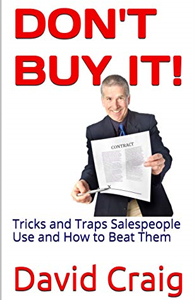(On a lighter note today, here’s an article I have on the Daily Express website)
If you�re ever with someone who is trying to sell you something � a home, car, insurance, clothes, new phone or whatever � here are 10 common tricks and traps you should look out for.
The Probe On your first contact with any salesperson, they�ll usually ask you a few questions. These have two main goals. Most obviously, they�re trying find out what you�re looking for. But they�re also aimed at finding out how serious you are about buying. For example, a car dealer would want to work out if you�re a tyre-kicker (someone who is just looking around but not intending to buy) or a fish (someone who can be caught and reeled in).
The Psychology Test To be successful in selling to you, a seller must quickly work out what kind of a person you are so they can adjust their sales pitch to appeal to someone like you. If you�re a positive, extrovert, glass-half-full person, then they�ll probably try to sell the dream � stress how what they�re selling will improve your life. But if you�re more of a glass-half-empty worrier, then the seller will sell security � focus more on the features and performance of what�s being sold.
The Make-a-Friend Sellers will have many tricks to make us like them as the more we like someone, the more likely we are to buy from them. One of the most frequently used techniques is called active listening. With active listening the seller will use all kinds of non-verbal gestures such as leaning forward, inclining their head slightly to one side, widening their eyes, pursing their lips thoughtfully and stroking their chin to show their interest in us. Some sellers even sit in front of the mirror at home practising their active listening skills.
The Trust Me Many salespeople are trained to portray themselves as trusted advisers helping us make the right buying decision rather than being seen as commission-hungry vultures slavering to get hold of our money. One of many ways of achieving this is the same side of the table.� Rather than standing or sitting opposite the customer creating a situation where the seller and buyer are like adversaries facing each other, the seller changes their position so they�re standing or sitting almost beside the customer as if they�re working together with the customer to solve the customer�s problem � which house, car, TV, phone or insurance to buy.
The Persuaders Having managed to get us interested in buying something, the seller then needs to get us to make the decision to move ahead. To put pressure on us, they might try the closing door � suggest there�s only a limited time to get the deal they�re offering; or the phantom buyer � tell us there are other people interested in buying what we want even if this isn�t true; auction fever � use other real or phantom buyers to make us feel we have to offer a higher price if we�re to get what we want; or even the deliberate mistake � when adding up the price of something, they deliberately �forget� some small part so that the buyer, thinking they�re smarter than the seller, rushes to complete the deal.
The One-Step Negotiation In the West, we�re used to most things we buy having fixed prices and so often feel uncomfortable haggling over price. Sellers understand this and will often quote an inflated price then allow us to negotiate a small reduction. Relieved at having supposedly achieved a price cut, most of us will then buy. Very few buyers will do two- three- and even four-step negotiations.
The Absent Authority If we do try to do more than a one-step negotiation, then a seller might use the absent authority trick. They could say something like, �I�d love to offer this at the price you want, but I�m not allowed to. If you want, I can ask my manager to see what they say�. Then off they�ll go to apparently fight for you against their tough sales manager. After a few minutes, they�ll come back with a small concession claiming this is the best they can do. But as the manager is an absent authority, you can�t negotiate any further.
The Feel-Felt-Found If a buyer is worrying about the price or features or reliability of what�s being sold, the seller might try the feel-felt-found. They may say, �I know how you feel. Many of our best customers felt like that, but when they bought this they found they were delighted at having gone ahead�.
The Close Most sellers will have the ABC (Always Be Closing) drummed into them by sales trainers and their sales managers. This means that at all stages of the sales process, sellers must be absolutely focused on the end result � closing the sale and getting their commission. Any seller who can charm customers, get them interested but doesn�t get the close will either have extremely skinny children or else no job at all.
SSI Once a seller has closed the sale, then it�s time for SSI (Sell Second Item). If we�re taking a car, SSI might be all kinds of extras, additional warranties and GAP and payment protection insurances. If we�re buying a suit, SSI might include a couple of shirts, ties and a belt. With TVs or phones, SSI would be a care plan � paying a lot of money for an extended guarantee. And with a home, an estate agent might pressure us to take out a mortgage with the mortgage broker used by their agency.
David Craig is the author of DON’T BUY IT Tricks and Traps Salespeople Use and How to Beat Them (Thistle Publishing. Available only�from Amazon)














I heard about a sales technique called the McClave nod.(I think) Apparently this sales chap would start nodding when he reached an important part of his pitch. The general idea was that the punters would start nodding along in agreement. (politicians tend to use this, watch out next time they’re interviewed!)
Not sure why you’re so against selling in general. After all business and money make the world go around. There’s nothing wrong in selling a good product at a fair price to people who want and need it. I’m not keen on high pressure stuff myself, but selling creates employment.
It’s called the “Sullivan Nod” (page 190 of my latest book). I’m not against selling at all. All I’ve done is to try to explain to people about 100+ sales techniques which they may not be aware of.
G’day, that was a great summary! Lots of high-quality information, I am
excited that I stumbled on it.
I amm going to favorite your blog site!